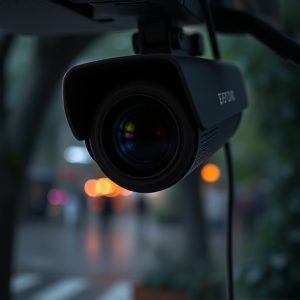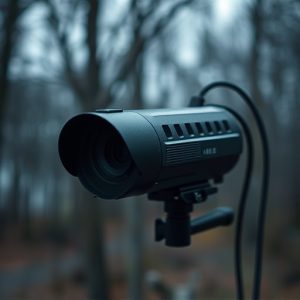Uncover Hidden Threats: RF Sweep Tutorial for Mini Spy Camera Detection at Night
Mini spy cameras have advanced with enhanced infrared technology, allowing for high-quality nighttim…….
Mini spy cameras have advanced with enhanced infrared technology, allowing for high-quality nighttime recordings. For optimal placement, map radio interference sources and calibrate your RF detector. Regular maintenance is crucial to keep up with technological advancements. To detect hidden mini spy cameras using an RF sweep, select a suitable detector, adjust settings for common camera frequencies, and verify signals through tracing or inspection. Advanced tips include using wide-range detectors, listening for beeps, and considering line-of-sight obstacles. Stay vigilant for discreet placements to ensure effective RF sweeps during nighttime recording sessions.
Uncover the hidden eyes that watch your every move with our comprehensive guide to detecting mini spy cameras using RF (radio frequency) detection during nighttime recording. These tiny, often undetectable devices pose significant privacy risks, but understanding their capabilities and employing effective techniques can empower you to expose them. Learn how to prepare for successful surveillance, follow a detailed step-by-step process, and avoid common pitfalls to ensure your safety in the digital age.
- Understanding Mini Spy Cameras and Their Capabilities
- Preparing for Nighttime Recording with RF Detection
- Step-by-Step Guide: Detecting Hidden Cameras Using RF Sweep
- Advanced Tips and Common Pitfalls to Avoid
Understanding Mini Spy Cameras and Their Capabilities
Mini spy cameras, also known as hidden cameras, have evolved significantly in recent years, offering advanced capabilities at an affordable price. These compact devices are designed to fit discreetly into various environments, making them perfect for surveillance and security purposes. One of their standout features is the ability to capture high-quality footage, even in low-light conditions, thanks to enhanced infrared technology. This makes mini spy cameras ideal for nighttime recording, ensuring clear images and videos without sacrificing visibility in the dark.
Whether it’s a small business owner looking to monitor their store or a concerned parent wanting to keep an eye on their child’s activities, these cameras provide a reliable solution. Their small size allows them to be placed virtually anywhere, from corners of rooms to hidden compartments, making them virtually undetectable. This level of discretion is a significant advantage, ensuring peace of mind and the capture of unaltered footage.
Preparing for Nighttime Recording with RF Detection
When preparing for nighttime recording with mini spy cameras, RF (radio frequency) detection plays a pivotal role in ensuring successful and undetected operation. The first step involves understanding your target environment. Identify potential sources of radio interference, such as nearby wireless devices or security systems, which could interfere with your camera’s signal. By mapping out these potential obstacles, you can plan an efficient route for your camera placement, minimizing the risk of false readings or signal dropouts.
Additionally, testing and calibrating your RF detector is essential. Ensure it’s properly tuned to detect the specific frequencies used by your mini spy cameras. A well-calibrated detector will enable you to accurately pinpoint the location of hidden cameras, making nighttime recording more effective. Regular maintenance and updates for both the camera and detector are recommended to stay ahead of technological advancements in stealthy surveillance equipment.
Step-by-Step Guide: Detecting Hidden Cameras Using RF Sweep
Step-by-Step Guide: Detecting Hidden Cameras Using RF Sweep
To detect mini spy cameras, particularly those performing nighttime recordings, using an RF (radio frequency) sweep involves a meticulous process. Begin by acquiring an RF detector suitable for identifying wireless devices. Next, power down all electronic equipment in the area to eliminate interference from other signals. Ensure you’re in a quiet, low-signal environment for accurate readings.
Next, adjust your RF detector’s settings to scan across the spectrum, focusing on frequencies commonly used by mini spy cameras. Gradually increase the sensitivity while maintaining stability on the detected frequency. If successful, you should observe a steady signal indicating the presence of an active camera. Verify the source using a tracer or by physically locating the device—often hidden in corners or behind objects—to prevent any unwanted surveillance.
Advanced Tips and Common Pitfalls to Avoid
When using mini spy cameras for nighttime recording, it’s crucial to employ advanced tips that enhance detection accuracy. One tip is to utilize a wide-range RF detector capable of picking up signals across various frequencies. This ensures you don’t miss hidden cameras operating on lower or unusual frequencies. Additionally, test the detector in advance with known signal sources to calibrate your senses and anticipate potential interference from common electronic devices.
Avoiding common pitfalls is equally important. Don’t limit yourself to visual confirmation alone; listen for faint beeps or buzzing sounds that might indicate an active camera. Also, remember that line-of-sight isn’t always necessary; some mini spy cameras can transmit signals through walls and other obstacles. To avoid detection, these devices are often placed discreetly in everyday objects like plants, clocks, or light fixtures. Stay alert for these telltale signs to ensure effective RF detector sweeps during nighttime recording sessions involving mini spy cameras.
Uncovering hidden mini spy cameras has never been easier with the right tools and knowledge. By understanding the capabilities of these tiny devices and preparing for nighttime recording using RF detection, you can effectively detect and disable them. Our step-by-step guide provides a practical approach to searching for hidden cameras while advanced tips help avoid common pitfalls. With this information, you’ll be well-equipped to ensure your privacy, especially during the quiet hours of the night.


